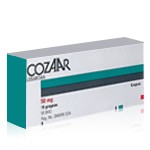Congestive Heart Failure: Causes, Symptoms, Life Expectancy and Stages


Congestive heart failure (CHF) is a chronic, progressive condition that affects the heart’s ability to pump blood effectively. Despite the term "failure," it does not mean the heart has completely stopped working. Rather, it indicates that the heart is unable to meet the body’s demands for oxygen-rich blood, which can lead to a range of health complications. Understanding the causes, symptoms, stages, and treatment options, including the role of medications like Cozaar, is crucial for managing this condition and improving quality of life.
What Is the Main Cause of Congestive Heart Failure?
Congestive heart failure is often the result of underlying conditions that damage or overwork the heart muscle. The most common cause is coronary artery disease (CAD), which occurs when the arteries that supply blood to the heart become narrowed or blocked due to plaque buildup. This reduces blood flow and can lead to heart attacks, which damage the heart muscle and impair its ability to pump effectively.
Another leading cause is hypertension (high blood pressure). Over time, elevated blood pressure forces the heart to work harder to pump blood, causing the heart muscle to thicken or weaken. This increased workload can eventually lead to heart failure.
Other contributing factors include cardiomyopathy, a disease of the heart muscle that can result from infections, alcohol abuse, drug toxicity, or genetic factors. Heart valve diseases, where the valves don’t open or close properly, can also strain the heart. In some cases, arrhythmias (abnormal heart rhythms) or congenital heart defects present from birth can lead to CHF.
Additionally, conditions like diabetes, obesity, sleep apnea, and even chronic kidney disease are known to increase the risk of developing heart failure.
Recognizing Heart Failure Symptoms
The symptoms of congestive heart failure can vary depending on the severity of the condition, but they generally stem from the heart’s reduced ability to circulate blood efficiently. One of the hallmark signs is shortness of breath (dyspnea), which may occur during physical activity, at rest, or even while lying flat. This happens because fluid backs up into the lungs (pulmonary congestion), making breathing difficult.
Fatigue and weakness are common due to the reduced oxygen supply to the muscles. People with CHF often feel exhausted after minimal exertion. Swelling (edema), particularly in the legs, ankles, feet, and abdomen, occurs as fluid builds up in the tissues. This can also lead to sudden weight gain from fluid retention.
Other symptoms include persistent coughing or wheezing, often producing white or pink, blood-tinged mucus, and an increased need to urinate at night. Some individuals experience a rapid or irregular heartbeat, as the heart tries to compensate for its weakened pumping ability.
In advanced stages, symptoms become more severe, and even simple activities like dressing or walking short distances can trigger breathlessness or extreme fatigue.
How Long Can I Live with Congestive Heart Failure?
Life expectancy with congestive heart failure varies widely based on several factors, including the underlying cause, the severity of the condition, response to treatment, and overall health status. Thanks to advances in medical care, many people with CHF live longer, healthier lives than in the past.
The prognosis often depends on the stage of heart failure at diagnosis. Early-stage heart failure, when symptoms are mild or absent, generally has a better outlook than advanced stages. According to research, the average survival rate after a heart failure diagnosis ranges from 5 to 10 years, but many individuals live well beyond this with proper management.
Lifestyle changes, such as adopting a heart-healthy diet, regular exercise, quitting smoking, and managing stress, can significantly improve life expectancy. Strict adherence to prescribed medications and regular follow-ups with healthcare providers also play a crucial role. For some, advanced treatments like implantable devices or even heart transplantation can extend survival.
However, heart failure is a progressive disease, and it’s essential to recognize that, despite optimal treatment, it may worsen over time. Open discussions with healthcare professionals about prognosis, goals of care, and quality of life can help individuals and their families make informed decisions.
The Four Stages of Congestive Heart Failure
Congestive heart failure is classified into four stages (A, B, C, and D), as defined by the American College of Cardiology (ACC) and the American Heart Association (AHA). This staging system helps guide treatment decisions based on the disease’s progression.
Stage A: This is the pre-heart failure stage. Individuals do not have symptoms yet but are at high risk due to conditions like hypertension, diabetes, obesity, or a family history of heart disease. The focus here is on aggressive risk factor management to prevent progression.
Stage B: In this stage, there is structural heart disease (such as damage from a previous heart attack or valve disease), but no symptoms of heart failure. Medications like ACE inhibitors or ARBs (such as Cozaar) are often introduced to slow disease progression.
Stage C: This stage includes people with structural heart disease and current or past symptoms of heart failure, such as shortness of breath, fatigue, or fluid retention. Treatment becomes more comprehensive, combining medications, lifestyle changes, and, in some cases, devices like pacemakers.
Stage D: Also known as end-stage heart failure, this stage involves severe symptoms that persist despite maximum medical therapy. Patients may require advanced interventions like heart pumps, continuous intravenous medications, or heart transplantation.
The Role of Cozaar in the Treatment of Congestive Heart Failure
Cozaar (losartan) is an angiotensin II receptor blocker (ARB) commonly prescribed for managing heart failure, particularly in individuals who cannot tolerate ACE inhibitors due to side effects like a persistent cough. It works by blocking the action of angiotensin II, a hormone that causes blood vessels to constrict. By preventing this constriction, Cozaar helps relax blood vessels, lower blood pressure, and reduce the heart’s workload.
In the context of heart failure, Cozaar’s benefits are multifaceted. It helps reduce afterload, which is the resistance the heart must overcome to pump blood. This decreases the strain on the heart muscle, improving its efficiency. Cozaar also reduces fluid buildup by promoting better kidney function, which is particularly important in CHF, where fluid retention is a major issue.
Clinical studies have shown that ARBs like Cozaar can improve survival rates, reduce hospitalizations, and enhance the quality of life for people with heart failure. It is often prescribed alongside other heart failure medications, such as beta-blockers, diuretics, and mineralocorticoid receptor antagonists.
Cozaar is generally well-tolerated, but like all medications, it can cause side effects. The most common include dizziness, fatigue, and elevated potassium levels. Rare but serious side effects include kidney dysfunction and severe hypotension. Regular monitoring of kidney function and electrolyte levels is essential for patients on Cozaar.
Final Thoughts
Congestive heart failure is a complex condition with a variety of causes, symptoms, and stages. While it is a serious diagnosis, advances in medical treatments, including the use of medications like Cozaar, have significantly improved outcomes for many patients. Understanding the disease, recognizing symptoms early, and adhering to treatment plans can lead to a better quality of life and increased longevity.
Article Post: Editorial Team of RXShop.md
(Updated at Feb 11 / 2025)

